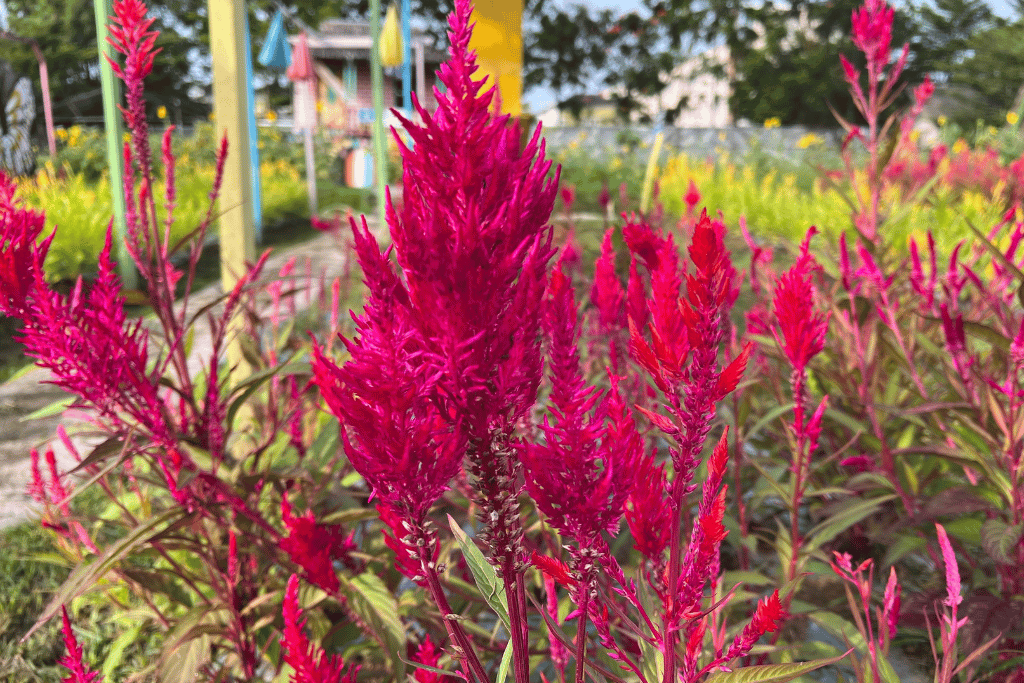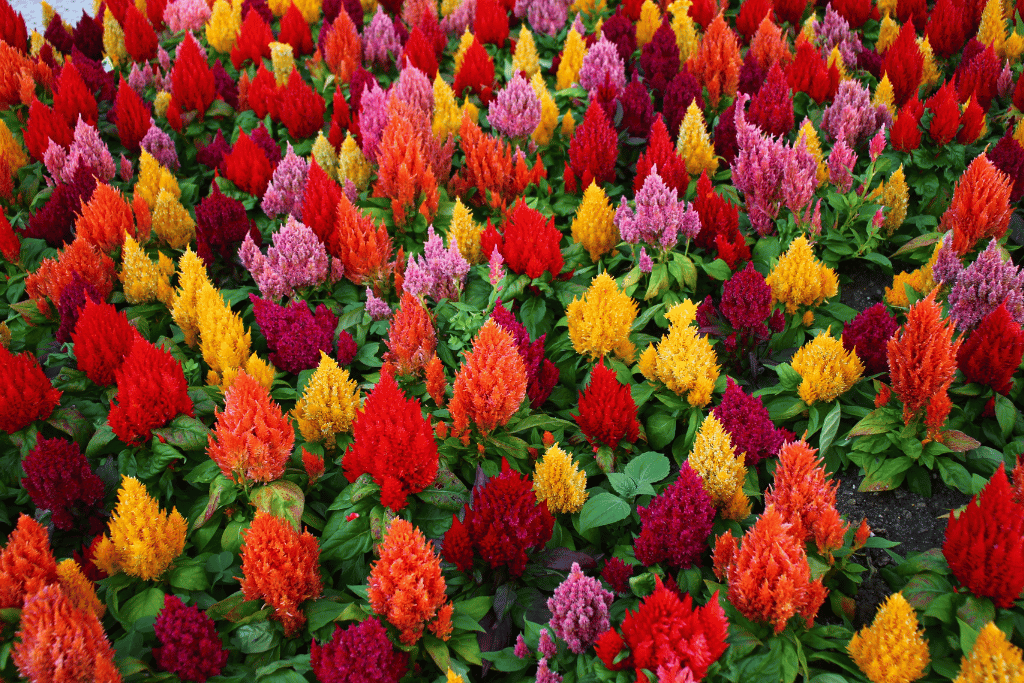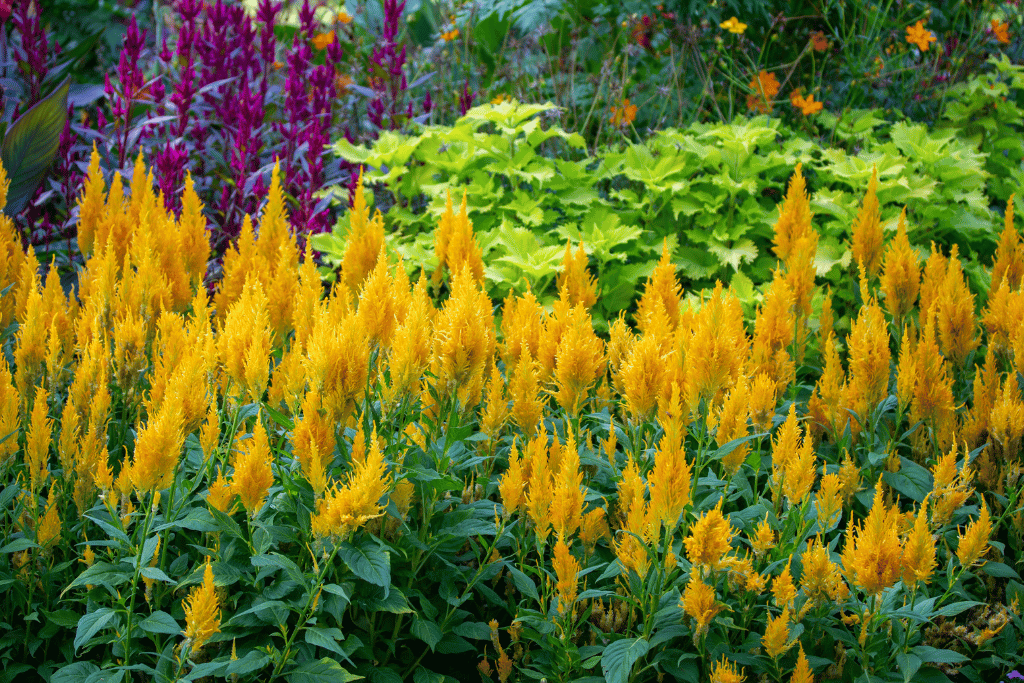
If you’re like me and love to make a statement with your plants, this fire-breather will surely fit the bill. Dragons’ breath plant, also known as Celosia, is one heck of a plant that’s bound to leave you speechless- even the name is enough to pique anyone’s interest!
This plant has a unique appearance with its vibrant red plumes that resemble flames- it will make your garden look like a dragon’s lair (if you plant enough of them!)
So, if you want to add a bit of fiery flare to your garden, the Dragon’s breath plant is the way to go!
Let’s take a look into the details of the Dragons breath plant, how to care for it, and how it’s used.
What are The Different Kinds of Dragon Breath Plants?

With so many different kinds of Dragon’s breath plants, their fiery foliage will surely blow you away. When it comes to the shape of their blooms, they come in plumed, spikes, and crested.
Plumed Celosia plants have feathery blooms that resemble flames or rooster Coombs, while spiked Celosia plants have pointed spikey flowers. Crested Celosia plants have unique ruffled blooms that look like the crest of a rooster.
On top of all of that, there are different colors:
First of all, there is a Dragon’s breath Red- This is the OG of the Dragon’s breath family. This plant is a real firecracker with its bright red plumes that are resemblant to a blazing inferno. This stunner is sure to turn heads, especially when planted with other bold and beautiful plants that can keep up with their striking appearance. Consider pairing it with some deep greens or purple to create a stunning contrast.
I have mine planted with other hot colors, like orange and yellow flowers, for an extra explosion of color.
Next up is the Dragons breath Black or Celosia Dracula– The rebel of the family. The black foliage adds a mesmerizing touch to your garden, so if you’re feeling a little edgy, this plant is the perfect addition. The foliage of this plant is a deep green, almost black in color, and when paired with some lighter greens or whites, it creates a stunning contrast that really makes it stand out. Or you could go all in on the dark theme and plant it with other dark-colored plants for a more mysterious look.
Lastly, we have the Dragons Breath White- This is the angel of the family. The delicate white plumes are like little wisps of smoke rising from a dragon’s lair. If you’re looking for a more serene look in your garden, this plant is a great choice. To make this divine beauty shine, you should plant it with other plants that match its heavenly personality. Think about growing it with some light blues or purples to create a stunning contrast that will make it stand out. To create a subtle look, you can plant them with other white or pastel-colored flowers, which will create an elegant appearance.
Because of their diverse range of foliage, you can have a go at mixing and matching them to create the look that best suits your taste.
Let’s take a look at some of the other details of this plant.
Are Dragon Breath Plants Perennial or Annual?

Celosia plants are from the Amarantheceae family and are typically grown as an annual, although some cultivars may be perennial in warm climates. The Dragon’s breath Red and White are annuals, so they complete their lifecycle in one growing season. But don’t fret; just because they’re annual, it doesn’t mean they won’t make a significant impact on your garden. In fact, they are known for their long-lasting blooms, so you can enjoy their fiery display all season long.
On the other hand, Dragons’ breath black is a perennial, meaning it will come back year after year. It may not be as showy as its annual counterparts, but it will provide a reliable source of dark foliage to balance out your garden’s palette.
So, you can’t go wrong if you choose a perennial or annual dragon’s breath plant. Both types will add a fiery touch to your garden and make it the envy of the neighborhood!
How Do You Take Care of a Dragons Breath Plant?

Suppose you get your hands on one (or more) of these fiery beauties; you’re probably wondering how do I take care of this plant. Well, don’t worry; I’ve got you covered!
Here are some tips on how to keep your Dragons Breath plants thriving:
Watering
Dragon’s breath plants prefer moist but not soaked soil. It’s important not to let the soil become too dry or waterlogged as either extreme can cause stress on the plant. To water Celosia, it’s best to water deeply and thoroughly, allowing the water to soak down to the root system.
Depending on the climate and growing conditions, this may mean watering once or twice a week. This frequency may increase in hot or dry weather as the soil tends to dry out quicker, and vice versa for cooler weather. You can always check the moisture content of your soil by sticking your finger in the top 2 inches. If the soil is dry, your finger will come out clean, and you can give them a drink.
When watering, try not to water over the top of the plant, as this can cause damage to the leaves and increase the risk of fungal diseases. Instead, aim to water around the base of the plant.
Soil
Celosia flourishes in well-draining soil that is light and airy. If the soil is too dense, the roots may have trouble growing and expanding, which can stunt the growth of the Dragons Breath plant. Another vital factor to consider if you are planting in a pot, make sure it has drainage holes where the water can escape and prevent the soil from becoming soggy. Try to steer clear of heavy clay-like soil that will add weight and pressure to the roots, and if it’s the only option, you can amend it with some perlite or bark to improve drainage.
It’s always a good idea to add some organic matter to the soil anyways. I use compost or well-rotted manure to help improve the soil’s fertility. Not only does it add nutrients, but it makes it easier for the roots to absorb the nutrients.
When planting the Celosia, make sure you dig a hole deep enough to accommodate the root ball but not so deep it gets lost in the soil. Gently press the soil around the base of the plant, like giving it a big hug to help secure it in place. With the correct soil conditions, your celosia will flourish and bring joy to your garden.
Light
When it comes to choosing a prime spot in your garden, try to find a place where the Dragon’s breath plant will receive 6- 8 hours of direct sunlight daily. This plant loves to bask in the sunshine, where it can show off its vibrancy. That’s not to say that Celosia can’t handle a little shade. It can tolerate some light shade during the hottest part of the day; we all need a break from the sun at some point! Too much shade will cause the plant to become weak and leggy, so keep an eye on it; if it starts to change shape and grow in a different direction, you may need to move it.
Fertilization
Dragon’s breath plants don’t need a lot of fertilizer, but a little food now and then can do it wonders. Use a balanced fertilizer once a month during the growing season, and you will keep your dragons happy and healthy.
Have a look for a ratio of 10-10-10 npk fertilizer in your garden store or online. This is one of the most common ratios available and is straightforward to use. Follow the dilution methods on the pack, and you won’t have a problem. If in doubt, always err on the side of caution with fertilizer- overdoing it can cause your plant to burn, and it’s an ugly sight.
During the winter months, the growth will slow down naturally, so there’s no need to apply fertilizer at this point. As spring approaches, you can bring Dragon’s breath plants back from winter by cutting away the dead growth and giving it feed to prepare them for the following season.
Benefits of Dragon Breath Plants

The Dragons Breath plants are like a hot cup of coffee in the morning; they’ll wake you up and get you going! Their bright fiery blooms and an energizing feel to the garden making them a great pick me up on a dreary day.
But it’s not just their looks that make Dragon’s breath plants beneficial. These plants are also great for attracting pollinators like bees and butterflies. They are like a dragon’s hoard of treasure, with little buzzing jewels coming to collect their nectar!
If you’re a fan of cut flowers, then Dragon Breath plants are the gift that keeps on giving. Their long-lasting blooms are perfect for bouquets and arrangements. Because of the low maintenance requirements, it means you won’t have to slave over these in the garden. You just need to give them basic care, and they will do their fiery thing without too much fuss!
On top of all that- Their name adds some fun- who doesn’t want to have a garden full of plants that sound like they came straight out of a medieval fantasy?!
A Fiery Beauty Not for the Faint of Heart
After covering everything from different types of dragon breath plants to how to care for them, you can easily see what a delight they are to add to your garden. With their variety of colors, low maintenance, and ability to attract pollinators, it is no surprise these plants have become popular over the years.
Let’s not forget about the best part – having a long supply of freshly-cut flowers all season long. I love having flowers on display in my home, and the colors and shape of the Dragons’ breath flowers add excitement to the bouquet.
So, what are you waiting for? Fire up the car and go and stock up on these little flames of joy!



